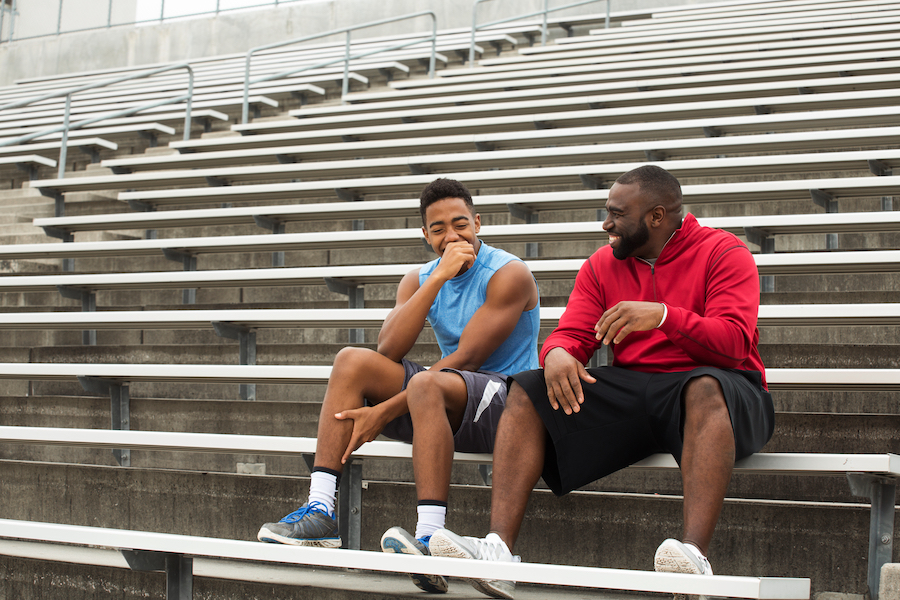Coaching is an art as well as a science. Your success as a private coach depends less on scientifically quantifiable factors such as duration, intensity, and frequency and more on less measurable factors that have to do with the psychological and sociological aspects of sport and business. That’s because, first and foremost, your clients are people—not a collection of numbers.
Don’t get me wrong, numbers certainly have a place in the coaching of endurance athletes and in running a business, but the psychological and social side of coaching is critical. The connection you have with your athletes depends on basic people skills, which we’ve emphasized throughout the Craft of Coaching series: listen more than you talk, express empathy, be trustworthy, have a positive attitude, develop a close working friendship, and show respect for your clients. Without these as your baseline, your chances of success are shaky at best.
Going one step beyond this is a more sophisticated skill that directly relates to the psychological and sociological make-up of your individual athletes. You need to cultivate an understanding of how your athletes perceive and interact with the world. This skill is at the heart of client retention.
Psychosocial skills deliver client satisfaction
A rock-solid coach-athlete relationship greatly increases the likelihood of the athlete performing at a high level and continuing with your coaching. But to help the athlete achieve a performance that meets or exceeds their expectations requires a lot more than a deep knowledge of sport science; it also demands that you have a working understanding of psychosocial skills. These skills will pay dividends when the client finishes their final race of their season. You might deliver athletic success, but will your athlete also feel personally satisfied and willing to continue working with you?
A solid coach-athlete relationship grows over time if the bond is nurtured by the coach. A knowledgeable and wise coach can have a huge influence on both the physiological and the psychosocial development of the athlete. Work to create a relationship that motivates the athlete to excel, while also building a close bond with you. This leads to satisfaction in your coaching, which, in turn, leads to retention.
Score your coach-athlete relationships
One of the first attempts by researchers to explain how the coach-athlete relationship could be quantified and enhanced was led by Sophia Jowett and Nikos Ntoumanis. They put together a coach-athlete questionnaire known as the CART-Q to assess the working relationship.1 This questionnaire is still used today to understand how athletes and coaches view each other.
From their research, the authors proposed that there are three categories that are central to a sound coach-athlete relationship: closeness, commitment, and complementarity. In somewhat more common terms, we might call these emotions, shared thoughts, and behaviors. If the coach and athlete have high regard for one another in terms of these three criteria, then their relationship is sound and the athlete’s motivation to achieve at a high level is likely very solid. When the athlete holds the coach in high regard, it means they are satisfied with their coach. For the private coach, client satisfaction improves client retention and helps the business grow.
To determine the status of the coach-athlete relationship Jowett and Ntoumanis proposed 11 statements to be considered by both the athlete and the coach with each statement being scored on a scale of one (“strongly disagree”) to seven (“strongly agree”). It may be difficult to gather this information from your own clients as they are likely to give you the responses that they think you’d like to receive. But as you are developing and evaluating a working coach-athlete relationship, take the time to reflect on your perception of the athlete’s closeness, commitment, and complementarity as well as your own. This is an excellent self-evaluation tool, and even if you complete the questionnaire for the athlete based on how they seem to be responding to your coaching, it is likely to provide valuable insights.
Note that this questionnaire has not been formally directed at endurance athletes and their private coaches, but a follow-up study2 of 387 NCAA athletes and coaches offers some additional insight. In the athletes’ responses regarding their coaches the mean averages for each statement fell in the range of 5.34 to 5.86 on the scale of one to seven. Interestingly, male athletes gave their coaches higher ratings than female athletes, and athletes competing in individual sports responded with higher ratings than team sport athletes. Neither of these differences was statistically significant.
Let’s review the questionnaire backed by Jowett and Ntoumanis’s research and a panel of experts, along with my suggested takeaways for each category. Put yourself in the athlete’s place and respond to each of the statements that follow. If your personal rating of one of the statements relative to a client is less than five, then this is likely a relationship issue you need to work on with the athlete.
Closeness or emotions
The coach and athlete feel emotionally close to one another in that each has a sense of being cared for, liked, and valued. They also trust each other.
- I feel close to my athlete/coach.
- I feel committed to my athlete/coach.
- I feel that my sport career is promising with my athlete/coach.
How to foster closeness in the coach-athlete relationship
If the coach and the athlete trust each other they are likely to be mutually motivated to achieve the athlete’s goal. Trust is built by the coach from the ground up. Start by being a real, caring person, not just a number-crunching, win-at-all-costs, do-it-my-way coach. Share your experiences and feelings, both in sport and in life, at the appropriate times and ask about those of your athlete, much as you would with a new friend. Be cautious not to dig in too deeply at first. It’s a gentle process. Allow time for trust to grow.
Communicate honestly with your clients. Don’t sugar-coat feedback. And most certainly don’t place blame for setbacks on the client. If someone must be blamed, it’s you for not foreseeing the outcome. Communication includes not only the words you say but also your facial expressions, the tone of your voice, body language, hand gestures, expressed emotions, and other non-verbal communication methods. How exactly you communicate with the athlete will likely vary depending on your personal relationship, how long you have known the athlete, and the topic of the conversation.
Show genuine interest in your client. Ask questions to learn how they are interpreting progress. Inquire about things in their life that may have even a remote chance of impacting training and performance. But don’t dig too deeply if you sense reluctance. Leave it up to the athlete to tell you more—or not. The athlete must know that you care about them as a person and not just as an athlete. Offer positive reinforcement whenever possible—“yes,” “I agree,” “good point,” “I understand,” “got it,” and more.
The bottom line: The coach must be invested in demonstrating that they can be trusted.
Commitment or shared thoughts
This represents the coach’s and athlete’s shared perspectives (common goals, values, beliefs), which are developed from open channels of communication.
- I like my athlete/coach.
- I trust my athlete/coach.
- I respect my athlete/coach.
- I feel appreciation for the sacrifices my athlete/coach has experienced in order to improve their performance.
How to foster commitment in the coach-athlete relationship
You must have not only a solid working knowledge of the sport and how to prepare the athlete for their event, but you also need to know how best to convey all of that to your client. Your teaching methods may vary according to who the athlete is in terms of their experience, goals, knowledge, and desire to learn. Avoid telling the athlete everything you know in one session. This is most commonly done by coaches who feel a need to prove how smart they are. Feed the knowledge in small bites over a long period of time, and at those times when the athlete most needs the information.
Frequently smile, offer positive reinforcement, and affirm the athlete when they succeed at a new task, such as mastering a complex new skill, a hard workout completed, or overcoming a hurdle. When they don’t succeed, ask why and what you can do to help. Always remember that you are there for the athlete—not the other way around.
You must create a relationship in which the athlete feels comfortable trusting personal feelings or issues they are facing with you. This can be tricky. These may or may not have to do with the sport and their training. Be cautious in how you respond. Sometimes it is best to say nothing, but convey a strong sense of support.
Preparing the athlete for the event requires several critical planning steps (see Craft of Coaching Module 3). Including the athlete in this planning process is critical in several ways, not the least of which is their ownership of the finished product and the sense of a team commitment. To do this you must come to understand the athlete’s strengths and weaknesses. The weaknesses must be your primary focus. Honestly but carefully discuss these with the athlete to further enhance your relationship in working toward a common goal.
While a democratic style of coaching (listening) is usually better for building commitment, an autocratic style (telling) may have advantages with some athletes in some situations. For example, an autocratic style works best when the coach-athlete relationship is very solid, not when it’s just getting started.
Don’t be afraid to challenge your athlete, ask tough questions, and have in-depth conversations. This can be risky, but it can also strengthen the relationship. Know what your objectives are going into an important conversation. In these situations, keep empathy and respect foremost in your mind.
Complementarity or behavior
This reflects the coach’s and athlete’s co-operative interactions, especially with respect to training.
- When I coach my athlete/When I am coached by my coach, I feel at ease.
- When I coach my athlete/When I am coached by my coach, I feel responsive to their efforts.
- When I coach my athlete/When I am coached by my coach, I am ready to do my best.
- When I coach my athlete/When I am coached by my coach, I adopt a friendly stance.
How to foster complementarity in the coach-athlete relationship
Be mindful that a positive coach-athlete relationship nurtures the athlete’s passion for their sport—and for your coaching. Negativity has the opposite effect.
The coach’s behavior has a direct effect on the athlete’s performance. If your conversations and reactions imply to the athlete, even subtly, that you expect an athlete to have a poor performance, then that is likely to be the outcome. If, on the other hand, your behavior with the athlete implies high expectations, then a better outcome is more likely to happen. The athlete’s performance often reflects the coach’s expectations.
This doesn’t mean that every interaction you have with the athlete must be rainbows and butterflies. There are times when you need to point out how the athlete can do better. All of us can improve something. Just be cautious with the things you point out. Unrealistically high expectations are just as damaging as low expectations. What is the athlete doing well and what can be done to progress? The key is to avoid negativity while also building confidence.
Make it your goal is to build intrinsically motivated athletes who strive to perform at a high level. It is not an easy task. Since each athlete is unique, this will require a great deal of thought and careful implementation to realize. Tailor your athlete interactions to fit the unique needs of the client.
The most important takeaway here is that you are working with people, not athletic machines, who trust you enough to commission you to help them become better athletes. But the real challenge is to also help them become better people in a way that benefits them even when they aren’t training or competing. A good coach who accepts this challenge will build a strong and lasting relationship with the athlete.
References
- Jowett, S. and N. Ntoumanis. 2004. “The Coach–Athlete Relationship Questionnaire (CART-Q): Development and Initial Validation.” Scandinavian Journal of Medicine and Science in Sports 14: 245–257.
- Fehr, C. M. 2017. “Examining the Coach-Athlete Relationship as a Predictor of NCAA Student-Athlete Satisfaction.” Graduate Student Theses, Dissertations, & Professional Papers: 10943.





